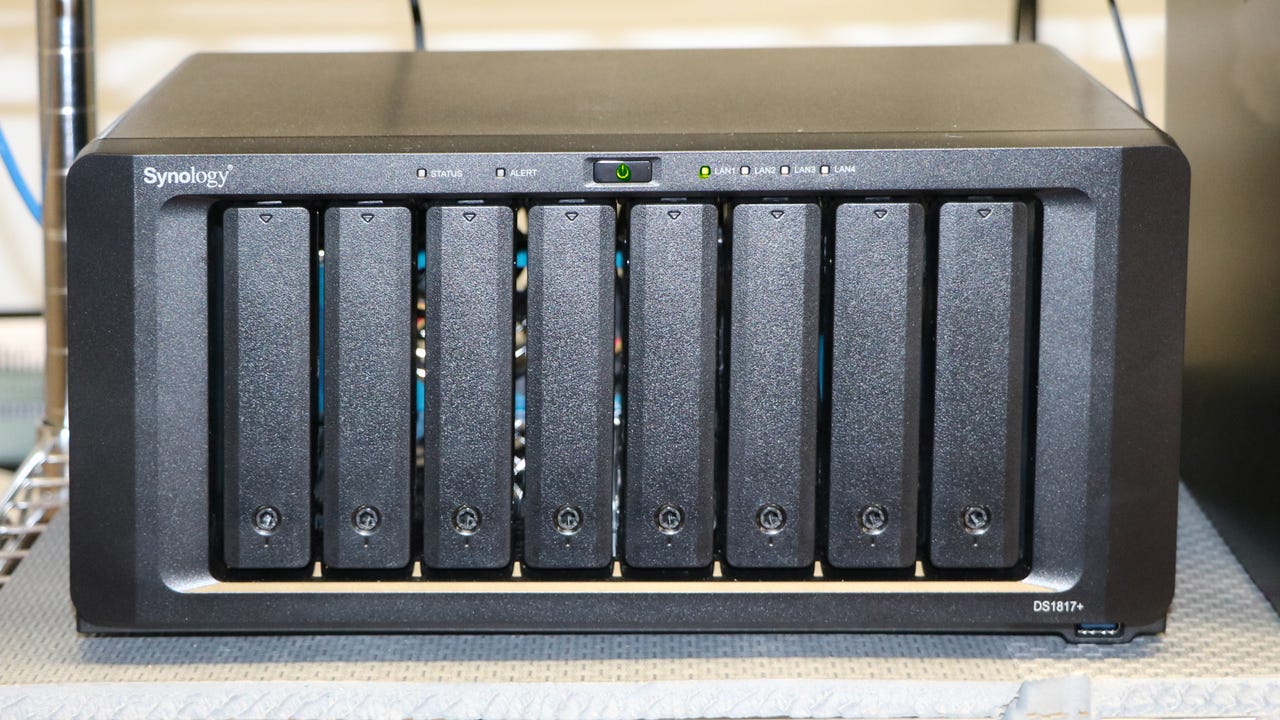Storage improvements have outperformed Moore’s Law by a factor of 800%

I woke up this morning to an error alert from my Synology server. Our server just hit the 80% usage threshold, which is the point at which it’s supposed to alert me to the need for more storage.
We use this server for backups and file sharing, mostly. It’s a mission-critical device that’s part of my little company’s overall storage strategy. It’s very important to make sure there’s enough space.
Also: The best network-attached storage
Fortunately, that’s a fairly easy fix. As you can see from the storage chart below, I’m running two 3.6TB drives. I simply need to replace them with bigger drives.
Synology’s DiskStation Manager (DSM) is great with that. The server RAID is set up so I can safely remove one drive at a time to replace it, without any system degradation. All I have to do is pull one drive, put in its larger replacement, and wait for the server to rebuild onto that drive. Then, a few days later, I’ll need to do the same with the second new drive. After the second new drive is integrated into the system, the storage pool will expand to use most of that new space.
Also: Optimize Mac Storage can make your files go poof. Ask me how I know
Now, here’s the thing. I just bought two 16TB drives for $589. That’s for both. Individually, each drive is $294. Now, don’t get me wrong. I don’t like spending that much money. But storage capacity is an important cost of doing business.
Compared with earlier storage, it’s a steal
Back in the 1980s, I worked for an early RISC-architecture super minicomputer maker by the name of Pyramid Technology. It was eventually bought up by Siemens, but back then, it was a darling of the venture capitalists. The company’s then-innovative architecture offered twice the computing power for two-thirds the price of the market leader.
As part of that offering, you could get a Fujitsu Eagle drive. This thing was about the size of two microwaves placed one behind the other and about the weight of a full refrigerator. It cost more than $10,000 in mid-1980s money (roughly $27K today). It held 470 megabytes. Not gigabytes. Not terabytes. Megabytes.
The purchase I made today gives me 68 thousand times more storage for 1/45th of the price of those big drives (when you calculate inflation and relative purchasing power).
Also: The best external hard drives you can buy
Plus, it took weeks to ship those super-heavy drives. They showed up at Pyramid on palettes delivered by 18-wheeler semitrucks and took a team of people to load them in. My new drives will arrive at my house tomorrow, delivered by one delivery person in a Honda Civic or an Amazon van, depending on the package load at the local warehouse. And shipping is included in my Amazon Prime membership.
By the early 1990s, storage pricing had come down quite a bit. I bought a 300MB drive (no brand name) for $1,000 (roughly $2,300 in today’s money). That drive was almost exactly the size of my Mac Studio, but a bit heavier.
Also: This $75 dock turns your Mac Mini into a Mac Studio (sort of)
The purchase I made today gives me 106,000 times more storage for about one-quarter the price.
It’s hard to picture 106,000 times more storage. Let’s try to conceptualize it using distance. Try this on for size.
The Ikea store in downtown Portland Oregon is 2,800 miles from the Capitol Building in Washington, DC.
The front steps of the Capitol Building are about 126 feet from the famous rotunda in the middle of the building.
Making an analogy of storage to distance, that 300MB drive I bought in 1990 would only get you from the rotunda to the front steps of the Capitol. The 32TB drives I bought today would get you from the Capitol Building rotunda to the Ikea in Portland, Oregon, on the other side of the continent.
Let’s end with a quick discussion of Moore’s Law. Moore’s Law is named after Intel founder Gordon Moore, who postulated that chips will double in the number of transistors every two years, while simultaneously dropping to half the price. Moore’s Law is often pointed to as an example of extreme improvement. But Moore’s Law is a sad cousin to storage improvements. That jump from 300MB to 32TB outperforms Moore’s Law eight times over.
Storage has come a long way. Stay tuned. In the next few weeks, I’m planning on refining my storage architecture and adding another server. I’ll tell you all about it when it’s in place.
What’s the biggest storage block you’ve ever purchased? Let us know in the comments below.
You can follow my day-to-day project updates on social media. Be sure to follow me on Twitter at @DavidGewirtz, on Facebook at Facebook.com/DavidGewirtz, on Instagram at Instagram.com/DavidGewirtz, and on YouTube at YouTube.com/DavidGewirtzTV.
For all the latest Technology News Click Here
For the latest news and updates, follow us on Google News.
